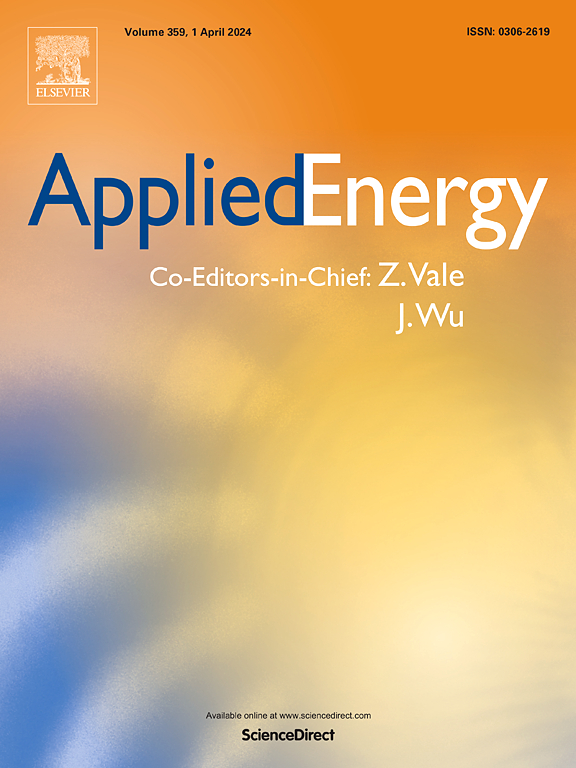Dynamic expansion planning of a commercial virtual power plant through coalition with distributed energy resources considering rival competitors
IF 11
1区 工程技术
Q1 ENERGY & FUELS
引用次数: 0
Abstract
We consider a virtual power plant (VPP) that expands its capacity by forming a coalition with decentralized energy resources (DERs) such as controllable and renewable power plants, as well as with energy storage systems and flexible demands. The VPP competes with rival VPPs to aggregate the DERs to its own portfolio. This problem is formulated as a three-stage stochastic bi-level model, where the expected profit of the VPP is maximized in the upper-level problem, while the lower-level problems deal with the decisions of each DER regarding the selection of VPP. In the first stage, the VPP manager places bids to secure each DER auction. The second stage involves decisions to determine the DER auctions, forming the VPP coalition and the procurement of power from the day-ahead market. Uncertainties in this stage include bid prices of rival VPPs and the minimum selling price of DERs. Finally, in the third stage, the expanded VPP determines its optimal operation and manages uncertainties related to renewable energy production levels and market prices. The conditional value-at-risk (CVaR) is incorporated into the model as a risk metric to deal with the profit risk associated with the decisions of the VPP manager. The duration of the coalition forming is mid-term, spanning one month. To reduce the computational burden of the problem, the variability of parameters such as market prices and renewable energy production levels (both solar and wind) is modeled using representative days generated by a clustering K-medoids method. Through a case study using data from the Spanish electricity market, it is demonstrated that weather conditions and electricity demand significantly influence the coalition formation.
考虑竞争对手,通过与分布式能源资源联合,制定商业虚拟电厂的动态扩展规划
我们考虑的虚拟发电厂(VPP)是通过与分散能源资源(DER)(如可控和可再生发电厂)以及储能系统和灵活需求组成联盟来扩大产能的。VPP 与竞争对手 VPP 竞争,将 DER 纳入自己的投资组合。该问题被表述为一个三阶段随机双层模型,在上层问题中,VPP 的预期利润最大化,而下层问题则处理每个 DER 关于选择 VPP 的决策。在第一阶段,VPP 管理者投标以确保每个 DER 的拍卖。第二阶段涉及确定 DER 拍卖、组建 VPP 联盟和从日前市场采购电力的决策。这一阶段的不确定因素包括竞争对手 VPP 的投标价格和 DER 的最低销售价格。最后,在第三阶段,扩大后的 VPP 确定其最佳运行方式,并管理与可再生能源生产水平和市场价格相关的不确定性。条件风险值 (CVaR) 作为风险指标被纳入模型,以处理与 VPP 管理者决策相关的利润风险。联盟形成的时间为中期,跨度为一个月。为了减轻问题的计算负担,使用 K-medoids 聚类方法生成的代表日来模拟市场价格和可再生能源生产水平(太阳能和风能)等参数的变化。通过使用西班牙电力市场数据进行的案例研究表明,天气条件和电力需求对联盟的形成有重大影响。
本文章由计算机程序翻译,如有差异,请以英文原文为准。
求助全文
约1分钟内获得全文
求助全文
来源期刊

Applied Energy
工程技术-工程:化工
CiteScore
21.20
自引率
10.70%
发文量
1830
审稿时长
41 days
期刊介绍:
Applied Energy serves as a platform for sharing innovations, research, development, and demonstrations in energy conversion, conservation, and sustainable energy systems. The journal covers topics such as optimal energy resource use, environmental pollutant mitigation, and energy process analysis. It welcomes original papers, review articles, technical notes, and letters to the editor. Authors are encouraged to submit manuscripts that bridge the gap between research, development, and implementation. The journal addresses a wide spectrum of topics, including fossil and renewable energy technologies, energy economics, and environmental impacts. Applied Energy also explores modeling and forecasting, conservation strategies, and the social and economic implications of energy policies, including climate change mitigation. It is complemented by the open-access journal Advances in Applied Energy.
 求助内容:
求助内容: 应助结果提醒方式:
应助结果提醒方式:


